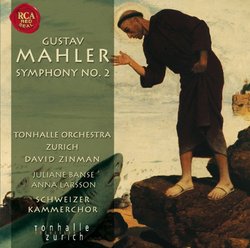| All Artists: Gustav Mahler, David Zinman, Zurich Tonhalle Orchestra, Juliane Banse Title: Mahler: Symphony No. 2 Members Wishing: 1 Total Copies: 0 Label: RCA Original Release Date: 1/1/2007 Re-Release Date: 5/29/2007 Album Type: Hybrid SACD - DSD Genre: Classical Styles: Historical Periods, Modern, 20th, & 21st Century, Symphonies Number of Discs: 2 SwapaCD Credits: 2 UPC: 828768715727 |
Search - Gustav Mahler, David Zinman, Zurich Tonhalle Orchestra :: Mahler: Symphony No. 2
 | Gustav Mahler, David Zinman, Zurich Tonhalle Orchestra Mahler: Symphony No. 2 Genre: Classical
|
Larger Image |
CD DetailsSimilar CDs
|
CD ReviewsVery nicely done. B. Guerrero | 06/01/2007 (5 out of 5 stars) "Disclaimer: I do not own an SACD player, so I'll be reviewing this in two-channel stereo only. Zinman's sudden decrescendo on the symphony's very first note - a string tremelo - might make you think that this is going to be a lightweight presentation of Mahler's gargantuan "Resurrection" symphony. But you'd be deceived in thinking that, as Zinman pours on dazzling brilliance with his bright cymbals and trumpets at the symphony's first ugent climax. This is the real deal. So; that being the case, let's jump to what matters most: the finale's ending. The dueling mezzo and soprano - Anna Larsson and Juliane Banse - work very well together on their tutti passage, if also a tad operatic sounding. When we get to the unison choral proclamation of "aufverstehen" (rise up), we get plenty of organ peddle, just as Mahler indicates. Best yet, when the chorus cuts out, we get more organ peddles and plenty of deep bells (played ad lib., as opposed to the spare interjections that Mahler wrote out). These are very nice sounding bells!!! - a refreshing change. At the very end, you can hear the alternating salvos from the high and low pitched tam-tams (large orchestral gongs), but not quite as much as on Ivan Fischer's excellent performance on Channel Classics. Still, this is a very well balanced and well nuanced ending with plenty of heft and excitement to go around. Everything else in the finale is as exciting and driven as it should be too. My one and only complaint with the fifth movement, is one that I have for more than half the recordings of Mahler 2 out there! At the final climax of the long march episode, Mahler writes a series - five in total - of quick strokes on the deep tam-tam that accompany the trumpets. These five rapid strokes are followed up by three interspersed ones. Well; as is so often the case, you simply can't hear them. This may seem like a minor point, but just listen to how much more effective this very same passage is on the underrated Leonard Slatkin recording (Telarc). But beyond this, I have no complaints. At "geschlagen" (to strike), the unison bass drum and cymbal strokes lift you right out of your chair, just as they should. All in all, this is a fine presentation of the long finale, with no excess dragging in the slower, quieter passages that dominate so much of its landscape. Anna Larsson is excellent in the fourth movement, if also a bit more hushed and rapt sounding than usual. I'll take it, so let's move on (backwards). At nearly 11 minutes with the second movement, and closer to 10 minutes with the scherzo, Zinman is a tad slower with the second movement than I care for, and a tad faster with the scherzo than I like too - I wish those numbers were flip-flopped. But the musicality involved is never in question, as the four major sections of the orchestra are very well balanced: strings, woodwinds, brass and percussion. The harps are also more front and center than they usually are too. In the second movement, Zinman does a marvellous job of hamming it up at that remarkable passage for pizzicato strings, harps, and piccolo flute (my favorite section in the entire symphony, other than the ending). Although Ziman's scherzo is rather fast and fleet, he still get his clarinets - among others - to shape their phrasing with lots of crescendos and decrescendos. One passage that does fall somewhat flat, is the one where the four trumpets suddenly begin serenading back and forth to each other (accompanied by harps, arpeggiated strings, and trilling flutes). But the scherzo's main climax has plenty of heft, if also wanting just a tad in explosive power. Overall, I prefer the slower than normal tempo that both Klemperer and Ivan Fischer use for this movement. But Zinman still manages to plow up more fertile ground here than Boulez (DG), who truly just skated upon the surface in his scherzo movement (very odd). Zinman also makes the most of Mahler's wooden sounding col legno markings (hitting the strings with the wooden back of the bow). All of this brings us back to where we started: the first movement, which is a microcosm of the numerous moodswings Mahler conjures up throughout the symphony. Simply stated, I like Zinman's first movement. He stears a course that's between Walter's strict classicism (if such a thing exists in Mahler), and Bernstein's "live for the moment", overt romanticism. At the central climax, Zinman is quite clear in dealing with its dense textures and rhythmic polyphony (dissonant trumpets; descending strings; suspended cymbal crescendo), with plenty of heft at the orchestra's fortissimo, unison octave jump (descending, accompanied by two bass drum strokes) that cap this passage, and lead back into the recapitulation. You may have heard one or two central climaxes that are more powerful, but few that are as well balanced and just plain musical sounding. I alo like the strict, mentronomic tempo that Zinman keeps during the movement's final funereal procession - there's no rushing into that last climax (capped with a ringing gong stroke). Until now, I've been focusing on what happens in this recording in the most musical and objective means that I can muster. After all, how one reacts to what they hear is always a personal matter. At this point, it's difficult to make "best ever" type proclamations when so many outstanding recordings already exist. All I can tell you is that this is yet another really fine presentation of Mahler's eternal "Resurrection" symphony. Let's face it, we're really spoiled for choices when it comes to the Mahler symphonies. For that, let's be thankful. Now bring on Zinman's Mahler 3rd - I'll bet it's going to be next to outstanding. " Homerun for Zinman P. Weber | Los Angeles | 06/21/2007 (5 out of 5 stars) "Prior to hearing this M2 I never thought of David Zinman as a Mahler conductor. But overall this new M2 is very impressive and puts the music across very convincingly. We have fine playing, excellent sound quality and an interpretation that strikes all the high points without the baggage of other conductors. It's interesting to compare this new Mahler 2 to Fisher. While Fisher is impressive, I find Zinman more consistently enjoyable. The difference is in the details, as they say. Right from the start Fisher does something I don't like. At the beginning of the first movement the score calls for a wild upsurge from the bass section where the basses accelerate. This happens three times in the first movement. Fisher slows way down and then speeds up to achieve this affect - Rattle and Blomstedt also do this. To me it sounds terribly mannered and ruins the very affect Mahler asked for. Zinman, to his credit, does not employ this mannerism and the first movement sounds much better for it. In the second movement Fisher tries his hand at rubato but it doesn't sound convincing. MTT also does this but manages to pull it off better. Zinman is more subtle and achieves more coherence without sounding stiff. Also, the timing is about 10:30, not 11 as stated by the previous review. The third movement is diabolical in Zinman's hands, played at a flowing tempo but with all the right decisions. Zinman puts the fourth movement across better than Fisher for two reasons. First, I don't care for the excessive vibrato from Fisher's Contralto. Zinman's Contralto sounds better to me even though she is miked a bit closely. Second, Zinman allows us the hear the wonderful brass chorale in the beginning, where Fisher's brass chorale is very low and subdued. I suspect he has the brass play from a distance or off stage. Maybe the score calls for this but I prefer the chorale to be loud enough so I can at least hear the dam thing. Most conductors play the chorale the same way as Zinman. In V both recordings are excellent and I think it's a toss up. Fisher's ending may be a touch more cataclysmic but I don't care for his Soprano. I also find Fisher's off stage instruments are too far away and too difficult to hear. Zinman's perspective is better but his percussion is not always as loud as Fisher. But this is really a matter of taste. Zinman does just about everything extremely well and gives us a beautiful ending. At the end of the day I prefer Zinman, but both performances are fine." Mahler Symphony 2s in general, and this very respectable ver Mr John Haueisen | WORTHINGTON, OHIO United States | 04/13/2008 (5 out of 5 stars) "David Zinman's performance of Mahler's Symphony 2 is excellent, chiefly for how he maintains balance. If he varied the tempi a bit here and there, it was still well within the bounds of an expected performance of Mahler's "Resurrection" symphony.
This might be a good time to mention that if you're not familiar with why Mahler's second symphony is often referred to as "the Resurrection Symphony," it is because that was how he tried to explain its "meaning" to his new 20-year-old wife, Alma. Those of us who love this symphony may hear in it our own struggle for the meaning of life. Why must we die? Is there life after death? In this symphony, in both the music and the exquisitely beautiful words, Mahler and many of us find the answers. This is one of the special qualities of Mahler's works: although he publicly denied official "meaning" for his musical works, if you read about his life, you'll learn that he was always trying to come to terms with the life and death issues of existence. OK, enough about the biographical applications. Back to this performance: Soprano Juliane Banse and contralto Anna Larsson both sing in a manner that is pleasing, both technically and aesthetically. They sound great together. The chorus too, stays focused, and avoids that frequent problem of being too soft or of taking over the symphony--they sound "just right." I also like the way Zinman handles the crescendos. He controls them carefully so that they build up to the proper climax, without appearing too tentative OR too over-powering. It's a matter of balance, and Ziman keeps that in mind. Apologies for going back to a generic comment about all Mahler second symphonies, but for those who may wonder at the cover art: the man apparently talking to a fish is a reference to an earlier song by Mahler, titled "St. Antony of Padua, preaching to the fish." Instrumental variations on that song are the subject of the Third Movement of the Symphony 2. Even if you don't care about the background of this symphony, you will still be able to appreciate the vast beauty it expresses, and Zinman presents M2 very respectably." |

 Track Listings (1) - Disc #1
Track Listings (1) - Disc #1


